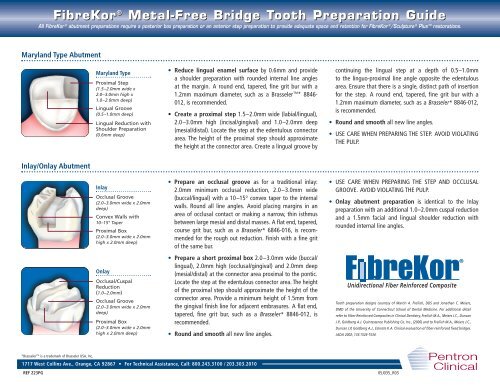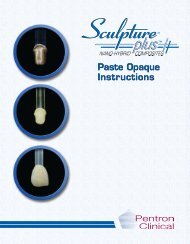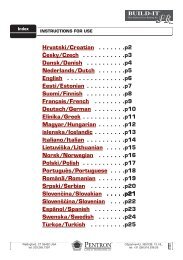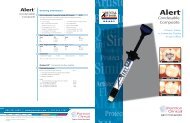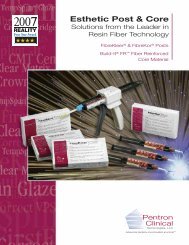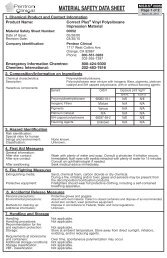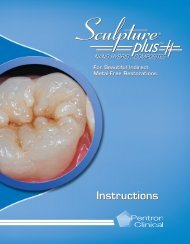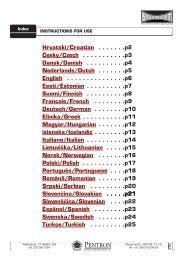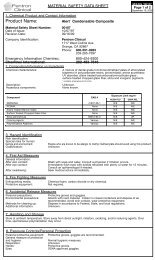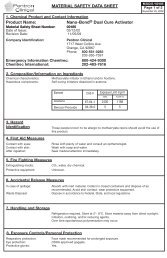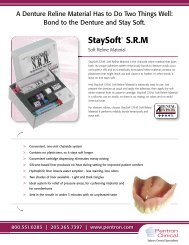FibreKor Dentist Prep Guide.4.qxd - Pentron Clinical
FibreKor Dentist Prep Guide.4.qxd - Pentron Clinical
FibreKor Dentist Prep Guide.4.qxd - Pentron Clinical
You also want an ePaper? Increase the reach of your titles
YUMPU automatically turns print PDFs into web optimized ePapers that Google loves.
<strong>FibreKor</strong> ®<br />
Metal-Free Bridge Tooth <strong>Prep</strong>aration Guide<br />
All <strong>FibreKor</strong> ® abutment preparations require a posterior box preparation or an anterior step preparation to provide adequate space and retention for <strong>FibreKor</strong> ® /Sculpture ® Plus restorations.<br />
Maryland Type Abutment<br />
Maryland Type<br />
Proximal Step<br />
(1.5–2.0mm wide x<br />
2.0–3.0mm high x<br />
1.0–2.0mm deep)<br />
Lingual Groove<br />
(0.5–1.0mm deep)<br />
Lingual Reduction with<br />
Shoulder <strong>Prep</strong>aration<br />
(0.6mm deep)<br />
• Reduce lingual enamel surface by 0.6mm and provide<br />
a shoulder preparation with rounded internal line angles<br />
at the margin. A round end, tapered, fine grit bur with a<br />
1.2mm maximum diameter, such as a Brasseler* 8846-<br />
012, is recommended.<br />
• Create a proximal step 1.5–2.0mm wide (labial/lingual),<br />
2.0–3.0mm high (incisal/gingival) and 1.0–2.0mm deep<br />
(mesial/distal). Locate the step at the edentulous connector<br />
area. The height of the proximal step should approximate<br />
the height at the connector area. Create a lingual groove by<br />
continuing the lingual step at a depth of 0.5–1.0mm<br />
to the linguo-proximal line angle opposite the edentulous<br />
area. Ensure that there is a single, distinct path of insertion<br />
for the step. A round end, tapered, fine grit bur with a<br />
1.2mm maximum diameter, such as a Brasseler* 8846-012,<br />
is recommended.<br />
• Round and smooth all new line angles.<br />
• USE CARE WHEN PREPARING THE STEP. AVOID VIOLATING<br />
THE PULP.<br />
Inlay/Onlay Abutment<br />
Inlay<br />
Occlusal Groove<br />
(2.0–3.0mm wide x 2.0mm<br />
deep)<br />
Convex Walls with<br />
10–15° Taper<br />
Proximal Box<br />
(2.0–3.0mm wide x 2.0mm<br />
high x 2.0mm deep)<br />
Onlay<br />
Occlusal/Cuspal<br />
Reduction<br />
(1.0–2.0mm)<br />
Occlusal Groove<br />
(2.0–3.0mm wide x 2.0mm<br />
deep)<br />
Proximal Box<br />
(2.0–3.0mm wide x 2.0mm<br />
high x 2.0mm deep)<br />
• <strong>Prep</strong>are an occlusal groove as for a traditional inlay:<br />
2.0mm minimum occlusal reduction, 2.0–3.0mm wide<br />
(buccal/lingual) with a 10–15° convex taper to the internal<br />
walls. Round all line angles. Avoid placing margins in an<br />
area of occlusal contact or making a narrow, thin isthmus<br />
between large mesial and distal masses. A flat end, tapered,<br />
course grit bur, such as a Brasseler* 6846-016, is recommended<br />
for the rough out reduction. Finish with a fine grit<br />
of the same bur.<br />
• <strong>Prep</strong>are a short proximal box 2.0–3.0mm wide (buccal/<br />
lingual), 2.0mm high (occlusal/gingival) and 2.0mm deep<br />
(mesial/distal) at the connector area proximal to the pontic.<br />
Locate the step at the edentulous connector area. The height<br />
of the proximal step should approximate the height of the<br />
connector area. Provide a minimum height of 1.5mm from<br />
the gingival finish line for adjacent embrasures. A flat end,<br />
tapered, fine grit bur, such as a Brasseler* 8846-012, is<br />
recommended.<br />
• Round and smooth all new line angles.<br />
• USE CARE WHEN PREPARING THE STEP AND OCCLUSAL<br />
GROOVE. AVOID VIOLATING THE PULP.<br />
• Onlay abutment preparation is identical to the Inlay<br />
preparation with an additional 1.0–2.0mm cuspal reduction<br />
and a 1.5mm facial and lingual shoulder reduction with<br />
rounded internal line angles.<br />
Unidirectional Fiber Reinforced Composite<br />
Tooth preparation designs courtesy of Martin A. Freilich, DDS and Jonathan C. Meiers,<br />
DMD of the University of Connecticut School of Dental Medicine. For additional detail<br />
refer to Fiber-Reinforced Composites in <strong>Clinical</strong> <strong>Dentist</strong>ry, Freilich M.A., Meiers J.C., Duncan<br />
J.P., Goldberg A.J. Quintessence Publishing Co, Inc., (2000) and to Freilich M.A., Meiers J.C.,<br />
Duncan J.P, Goldberg A.J., Eckrote K.A. <strong>Clinical</strong> evaluation of fiber-reinforced fixed bridges.<br />
JADA 2002; 133:1524-1534.<br />
*Brasseler is a trademark of Brasseler USA, Inc.<br />
1717 West Collins Ave., Orange, CA 92867 • For Technical Assistance, Call: 800.243.3100 / 203.303.2010<br />
REF Z23PG<br />
05J035_R03


